"OLD INDIAN RELICS."
Article first appeared in the New-York Daily Tribune on 12/14/1890.
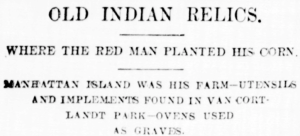
Below is a transcript of an 1890 article published in the Tribune concerning relics and human remains discovered under the Van Cortlandt Park Parade Ground. More recent scholarship has rendered some of the social history below inaccurate or obsolete. Additionally, references to “savage” customs and people are clearly no longer acceptable. However, the article has value as a primary source of information about the relics and remains uncovered in Van Cortlandt Park by, J.B. James, a local history lover and amateur archeologist. In some places I have added notes and extra context. The black and white line drawings were published with the article and the others I added. -Nick Dembowski
OLD INDIAN RELICS.
———————————————
WHERE THE RED MAN PLANTED HIS CORN.
———————————————
MANHATTAN ISLAND WAS HIS FARM–UTENSILS
AND IMPLEMENTS FOUND IN VAN CORTLANDT PARK
OVENS USED AS GRAVES
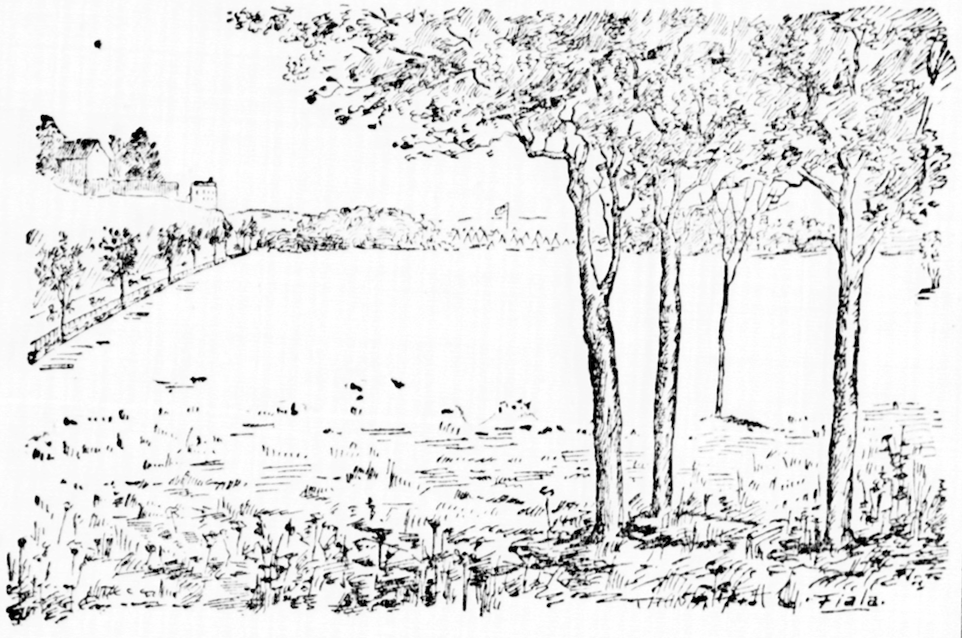
VAN CORTLANDT PARK–PARADE GROUND
The most important, however, of the ancient Indian settlements in that section, judging from its apparent size and the large quantity of remains found, was that which formerly occupied the ground in Van Cortlandt Park, now in course of preparation for a parade ground for the National Guard. This plot of ground lies just to the north of the old Van Cortlandt mansion, extending to Broadway on the west and the lake on the east, and running northwest some 2,000 feet, between the line of the Yonkers Rapid Transit Railroad and Broadway, and comprising a large level plain, forty to fifty acres in extent. The northern half of this tract is low meadow, somewhat swampy, and traversed from north to south, through its centre, by a brook, which, about midway of the whole plain, bends off at a right angle with its general course, and running eastward empties into Van Cortlandt Lake. Along the brook are beds of gray and dark blue clay, mingled with sand. The southern half lies higher than the northern, is level, and consists of a sand and gravel drift, with a loam top-soil. Here explorations have recently been carried on, and interesting relics have been found.
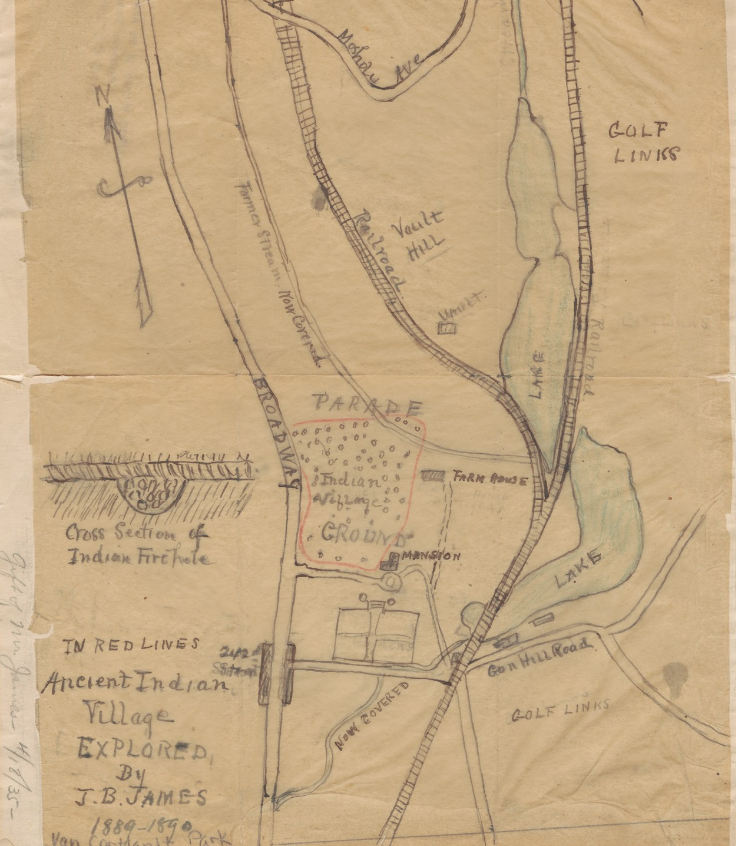
Map not included in original article: Reginald Pelham Bolton collection: notes regarding Indians near Inwood Hill Park, New York City, #9117. Division of Rare and Manuscript Collections, Cornell University Library.
The work of grading the parade ground was begun in May of the present year at the northernmost part of the lower half of the tract. The required level having been reached there, the excavation was carried back toward the mansion, due south, and extended from Broadway to the site of an old stone farmhouse, where a large willow tree is now standing. The process of grading consisted in ploughing up a small section, removing the earth so loosened in scrapers to the low ground that it was necessary to fill in, and repeating the operation as often as required to obtain the grade. In this way the soil was gradually sliced off to a depth ranging from two feet to about five feet. No better method could have been devised to bring to light any relics which might have found a hiding place there; and scarcely was the work fairly under way when many such were discovered in the numerous shell heaps uncovered from day to day. By mere chance the attention of John Bradley James, jr. an ardent student of archaeology living in Riverdale, near the park, was called to these discoveries, and, his interest being aroused, he determined if possible to procure any relics there might be, and save them from being carted away to the “dump,” and again buried under the soil.
Providing himself with the necessary instruments, the principal ones being a garden spade and a mason’s “pointing trowel,” Mr. James began a systematic search, which he has fortunately been able to continue almost to the present time, and he has secured an interesting, if not extensive, collection of relics, which shed much light on the old Indian manner of living.
When the workmen had removed a foot or so of earth, the tops of shell heaps began to show on the new surface. Sinking the spade a few times sufficed to disclose the diameter of the heap, and then a small trench would be dug close along one edge of the rim and as deep down as the shells extended. This would give a sectional exposure, forming what is called “a face.” The mass of shells would be worked through carefully with the trowel, the “face” being carried back until the heap was thoroughly examined. In this way anything that happened to be hidden in the shells would be found, although not all of the heaps yielded relics. Many that were so examined contained nothing whatever of value. And so with alternating good and bad luck the work advanced.
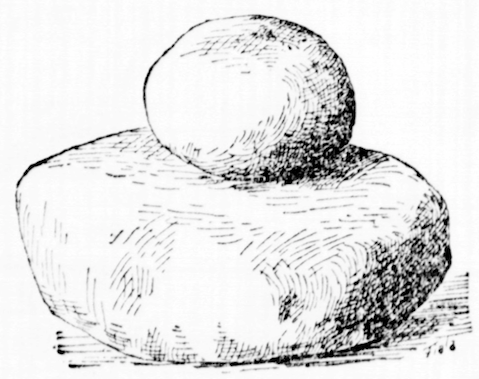
MORTAR AND PESTLE.
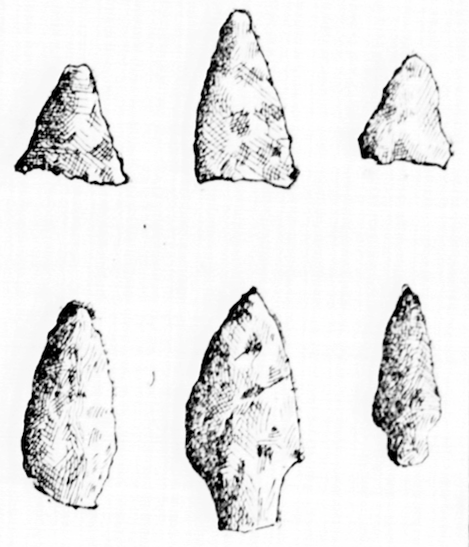
ARROW HEADS.
The shellfish were all obtained from the Spuyten Duyvil Creek and Harlem River, a little over a mile distant. A few oysters are still to be found in those places, and many persons now living can testify to the abundance and excellence of the Kingsbridge variety. The scallop and hard clam have almost, if not entirely, disappeared from those waters.
The shell heaps, or hearths, were found scattered over a space 650 feet wide by 950 feet in length, or an area equal to about fourteen acres, and were most numerous in the north and north central part, where for a considerable extent the soil was black with ashes and minute particles of charcoal, and thickly dotted with hearths. Throughout the whole fourteen acres they appeared at intervals, and often close together in groups.
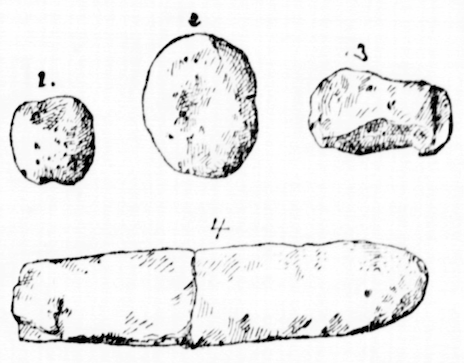
STONE IMPLEMENTS.
There can be little doubt that this plain was used as a planting field by the Indians, as all the conditions were favorable to that purpose. It is the largest level tract in this neighborhood, and for many hundreds of years at least has always been, as it is now, free from trees and underbrush, and possessing a loose, light soil that could be easily worked with the clumsy hoes fashioned from the shoulder blades of animals, or flat stone or large shells fastened to the end of a stick. The neighboring stream supplied fresh water; clay for making pottery was found along its banks, the neighboring woods teemed with game, and an inexhaustible supply of shellfish and other fish could be procured from the creeks near by. The spot met all the requirements of a savage mode of existence. Here the Indians built their huts, hunted their game, planted their corn and buried their dead, and finally passed away, leaving only a few rude implements and utensils to tell of their existence.
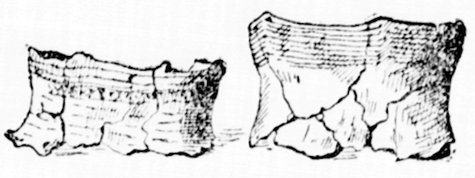
FRAGMENTS OF CLAY POTS.
The pottery discovered is made of coarse clay mixed with sand, and is unglazed. In color it is a dark reddish brown, and is usually ornamented only on the the neck and rim of the vessels with a series of lines and dots or geometrical figures. These have no set pattern, but show great individuality of taste, as among some forty odd specimens found by Mr. James no two are alike. No whole vessels have been found, but some of the fragments are of large size. The ornamentation is either impressed or scratched, the latter form being comparatively rare. In shape and decoration many of the vessels possess considerable artistic merit, which is exemplified particularly in a fragment of a small vessel in thin clay, showing the neck and rim. This has a square mouth, the brim rising at the corners and terminating there is a nodule. The ornamentation is scratched upon the clay in a series of lines and triangles. It is an unusually artistic production, hardly to be expected of a savage people.
Sufficient fragments of two large pots were found to complete, when glued together, about two-thirds of the neck and rim and to outline the other parts of the vessel. They measure, across the brim, 8 3-4 and 10 1-2 inches respectively. In the larger the decoration is on the rim only, while in the smaller it extends down on to the neck and body of the vessel. A number of low points rise from the top of the brims of both of these pots, giving them somewhat the appearance of crowns.
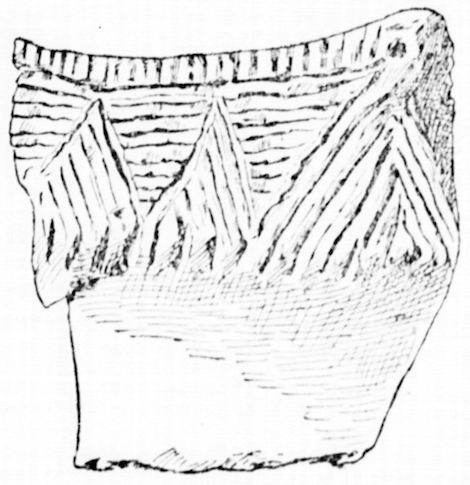
FRAGMENT OF CLAY VESSEL.
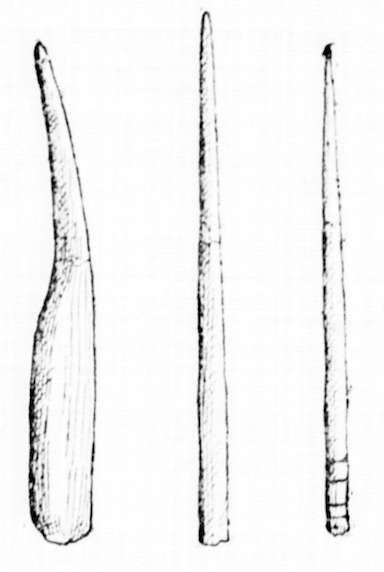
BONE NEEDLES.
Many stone and bone implements have also been discovered. Among the bone implements were articles somewhat resembling women’s large bone knitting needles, but shorter and flattened, with one end only sharpened, and an awl formed from one piece, the point being curved. The stone articles are ruder than might be expected of a people who produced such good pottery, and consist of arrowheads of what quartz and hornstone, a mortar and pestle for grinding corn, composed of a cobblestone slightly hollowed on one side for the mortar, and a rounded stone about the size of a man’s fist as the pestele; a rough stone hatchet, three or four pounding stones showing a battered surface, and a long, tongue-shaped stone chipped from a micaceous gneiss about fifteen inches in length, the name or use of which is not known.
Fragments of the bones and teeth of various animals were also obtained from the hearths, and among them were bones and antlers of the deer, jaws of the dog, bony plates from the back of the sturgeon, etc. Several charred hickory nuts showed that they also entered into the Indian diet. The larger bones had all been split lengthwise to get out of the marrow.
As to the probable age of the hearths and the remains found within them once can only surmise. The plain, as has been said, was cultivated by Van der Donck in 1649, so it is evident that no Indian village could have existed upon it in that year. The Indians must, therefore, have occupied it either before or after that date. It is possible that the Indians may have camped here during the uprising and massacre of 1655-1656, and if this was so, allowing two years for their occupation of the land, would bring the date down to 1658, the most recent we can assign, thus making the remains at least 232 years old. It required, however, a long time to form the vast numbers of shell heaps, and in view of this fact, and the fact that no articles were found that could have been obtained from the white man, Mr. James is convinced that they antedate the advent of the white man, and are the accumulation of years, beginning at some remote period back in the misty ages of the past.
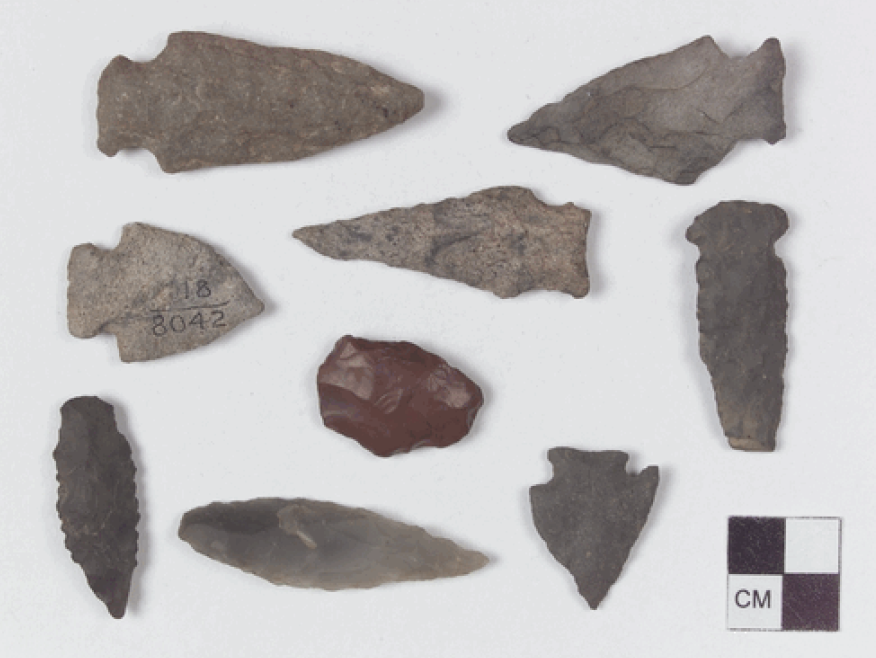
Arrowheads discovered by J.B. James in Van Cortlandt Park now in the collection of the Smithsonian
But who were these Indians, to what tribe did they belong? Fortunately some of the early navigators and settlers were men of intelligence; they have left accounts of the Indians, and so an answer to the question may be found in some of these writings. At the time of the Dutch colonization of New Netherland, about the 1623, the Indians who occupied what is now known as Manhattan Island and the east bank of the Hudson, as far north as Yonkers, or perhaps further, were the Manhattans, a branch of the great Mohegan Nation. The Manhattans were divided into many subtribes, one of which was known as the Weeckquaeskeeck, and owned the territory, which has been called Kekeskick, and Keskeskick, extending from about Fordham to the north line of Yonkers, and embracing all the land along the Hudson and the valley east of it. The land now comprising Van Cortlandt Park was once theirs, and the remains found in it are probably relics of their occupation.
It was the custom of the Indians of Westchester County to give names to their larger settlements, and it is probable that the village of Van Cortlandt Park had one. If so no trace of it has been found. Inquiry among some of the older residents in the neighborhood as to whether any relics had been found here in times past only elicited the information that none had ever been discovered, and even the members of the Van Cortlandt family themselves did not know until this summer that a Mohegan village formerly existed upon a part of their ancient domain.
The original home of the indians who occasionally camped on this plain is a mystery, and probably ever will be. All that is known is that they once lived there and have passed away, leaving as material evidence of their existence only some fragments of bones and a few rude implements that are stumbled upon by accident or found only after a careful search.
Notes and References:
1 – Robert Grumet and others doubt that there was ever a fort on Spuyten Duyvil Hill known as “Nipnicksen.”
2 – Paprinimen was used to refer to the land in the valley of today’s Bronx neighborhood of Kingsbridge. It became an island at high tide.
The idea that Van der Donck built his house at Paprinimen, “a short distance away” from his planting field (it was actually about a mile away) is contradicted by information in early deeds. Paprinimen was given to George Tippett by Van der Donck’s brother-in-law in 1668 and is described as “Land wch was once Youncker vandr Duncks.” However, the land that includes today’s Van Cortlandt Park was sold to George Tippett in 1670 and is described as the “Land & meadowe wch was formerly in ye possession & occupation [emphasis added] of old Youncker van der Dounck.” This makes it clear that Van der Donck did not live at Paprinimen but rather near his planting field in today’s Van Cortlandt Park. See: Minutes of the Executive Council of the Province of New York. edited by Victor Hugo Paltsis. Vol I, p. 200-201; and Westchester Deeds Liber A, p. 27.
Various forms of the word Wickerscreek were used by Dutch and English colonists to describe the indigenous people of The Bronx and Westchester. Some think the name comes from a settlement site in today’s Dobbs Ferry along a stream called Wicker’s Creek. If it translates as “birchbark country” that would be odd given the lack of birch trees growing in our area.
The term Keskeskick seems to be sourced to one deed. But the native settlement in Van Cortlandt Park was sometimes referred to the village of Keskeskick by local historians.
3 – According to Parks records, J.B. James was initially not given permission to excavate the site. Apparently, they changed their mind or he worked out some kind of arrangement with the construction workers on the site.
4 – Later in life, J.B. James wrote in a memoir that the hearths described above were the fireplaces inside wigwams or longhouses. “In the Van Cortlandt Park village [the hearths] varied in width from 2 to 3 feet and in depth from 18 inches to 2 feet. Serving both for cooking and for heat in winter it was also the receptacle of the house refuse–oyster shells, animal bones, etc., and had yet another and stranger use. When the owner of the hut died in winter, when the ground was frozen hard and covered with snow, the fireplace was enlarged, the body buried in it, in a flexed or doubled-up position, and the hut then burned or pulled down. In the village site mentioned, I found many skeletons of bodies so interred, as was evidenced by the ashes, charred bones of animals, oyster shells, etc. surrounding them.” March 1936 issue of the Riverdale News.
5 – Subsequent discoveries suggest that if the range of excavation had been expanded, the settlement area might have been significantly larger. Writing in the May 1935 issue of the Riverdale News, J.B. James wrote that: “A small camp site was also unearthed on the grounds of the Horace Mann school, on the westerly side of the athletic field. A quantity of shells was turned up, and I know of one skeleton, that of a child.” Additionally, in 1955, artifacts were discovered just west of Van Cortlandt Park on the other side of Broadway where today there is a Burger King:
6 – In 1895, the American Museum of Natural History accessioned human remains and artifacts into its collection that were uncovered by J.B. James. In 2024, the Stockbridge-Munsee Community, one of the three Federally recognized Lenape Tribes who are the descendants of these villagers, are working with AMNH on repatriating their Ancestors under the Native American Graves Protections and Repatriation Act (NAGPRA).